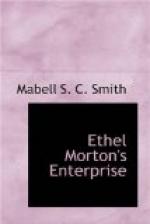James made a rush down to the brook and came back with a leaf of the pickerel weed and they handed it about and compared it with the lily of the valley leaf.
“Look at Ethel Brown’s oak leaf,” Helen continued. “Do you see it has a big midrib and the other veins run out from it ‘every which way’ as Ethel Blue said, making a net? Doesn’t it remind you of a feather?”
They all agreed that it did, and they passed around Margaret’s hat which had a quill stuck in the band, and compared it with the oak leaf.
“That kind of veining is called pinnate veining from a Latin word that means ‘feather,’” explained Helen. “The other kind of net veining is that of the maple leaf.”
Tom and Dorothy both had maple leaves and they held them up for general observation.
“How is it different from the oak veining?” quizzed Helen.
“The maple is a little like the palm of your hand with the fingers running out,” offered Ethel Brown.
“That’s it exactly. There are several big ribs starting at the same place instead of one midrib. Then the netting connects all these spreading ribs. That is called palmate veining because it’s like the palm of your hand.”
“Or the web foot of a duck,” suggested Dorothy.
[Illustration: Tom and Dorothy both had Maple Leaves]
“I should think all the leaves that have a feather-shaped framework would be long and all the palm-shaped ones would be fat,” guessed Della.
“They are, and they have been given names descriptive of their shape. The narrowest kind, with the same width all the way, is called ‘linear.’”
“Because it’s a line—more or less,” cried James.
“The next wider, has a point and is called ‘lance-shaped.’ The ‘oblong’ is like the linear, the same size up and down, but it’s much wider than the linear. The ‘elliptical’ is what the oblong would be if its ends were prettily tapered off. The apple tree has a leaf whose ellipse is so wide that it is called ‘oval.’ Can you guess what ‘ovate’ is?”
“’Egg-shaped’?” inquired Tom.
“That’s it; larger at one end than the other, while a leaf that is almost round, is called ‘rotund.’”
“Named after Della,” observed Della’s brother in a subdued voice that nevertheless caught his sister’s ear and caused an oak twig to fly in his direction.
“There’s a lance-shaped leaf that is sharp at the base instead of the point; that’s named ‘ob-lanceolate’; and there’s one called ‘spatulate’ that looks like the spatula that druggists mix things with.”
[Illustration: Linear Lance-shaped Oblong Elliptical Ovate]
“That ought to be rounded at the point and narrow at the base,” said the doctor’s son.
“It is. The lower leaves of the common field daisy are examples. How do you think the botanists have named the shape that is like an egg upside down?”




